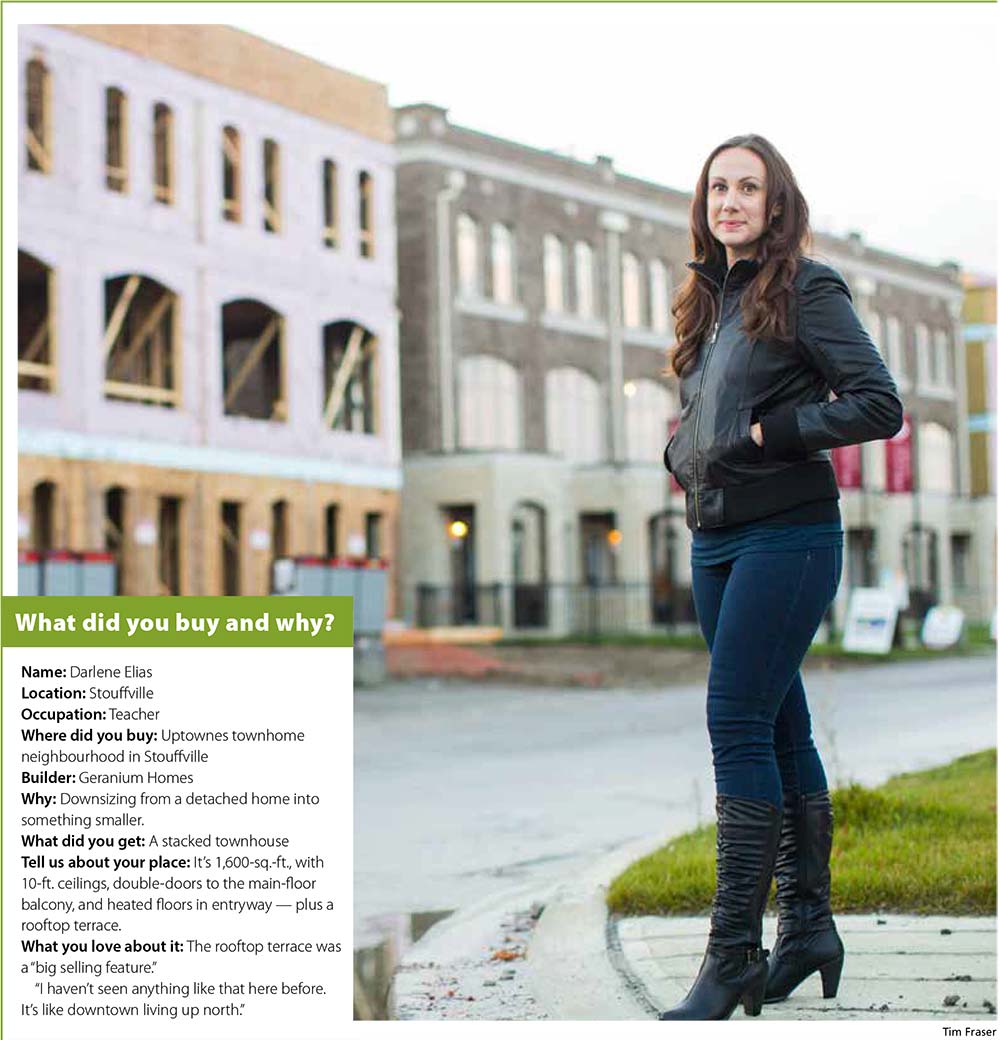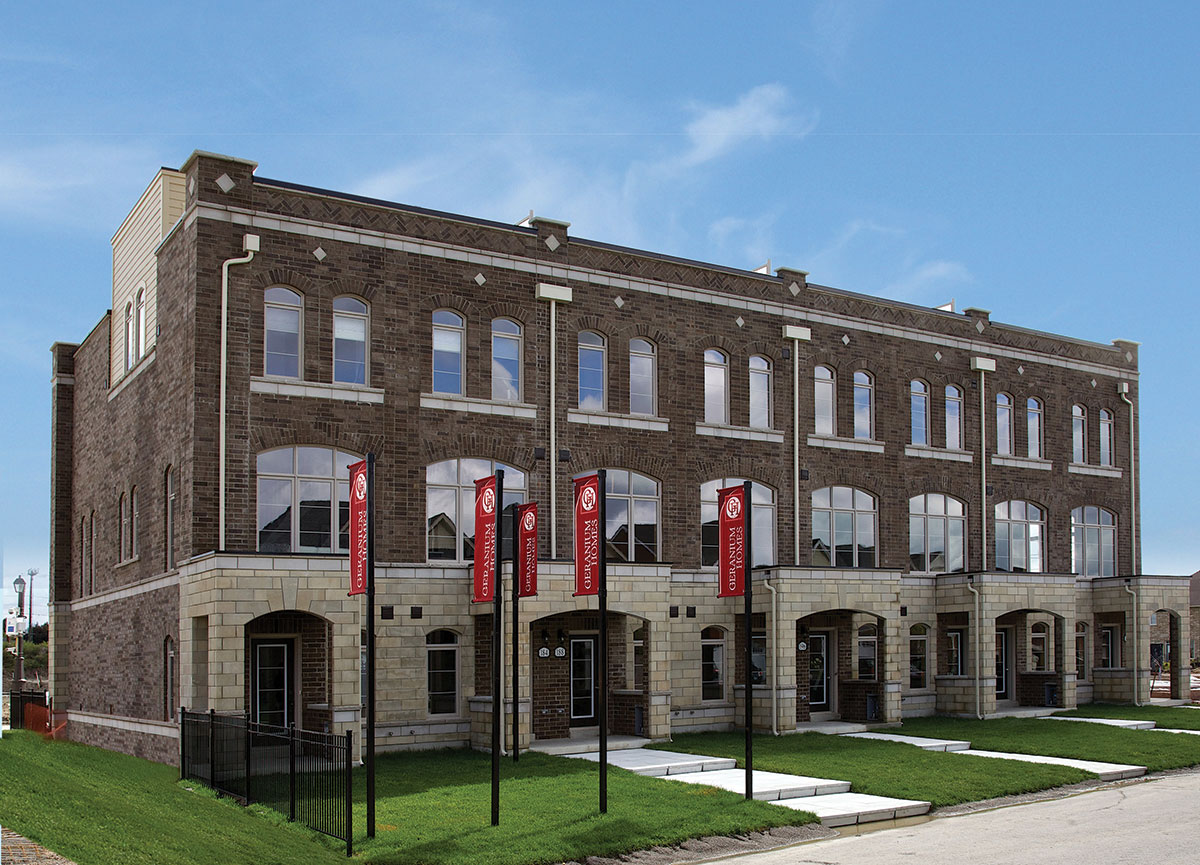Building Futures
in popularity across GTA
Denser development enables industry to hit growth-plan targets
Darlene Elias was inspired by the concept of a townhome the moment she walked into the sales centre for Geranium Homes’ Uptownes community in Stouffville.
“They’re so different from what you typically see north of the city,” says Elias, a local school teacher, noting that the urban-style townhome’s rooftop terrace was particularly appealing.
She toyed with the idea of moving into a condo at first. Ultimately, though, Elias decided she wanted a home that was set on the ground with its own front door.
She ended up buying a townhome at the Geranium community and she’s slated to move in this December. “It’s going to be my new house for Christmas,” Elias says.
She’s certainly not alone in her affinity for townhomes.
A LOW-RISE HOUSING ALTERNATIVE
BILD, the Building Industry and Land Development Association, notes that townhomes
have proven to be an effective way for its members across the GTA to meet the goals set out in the province’s growth plan for the Greater Golden Horseshoe region. The growth plan, Places to Grow, lays the groundwork for the region’s future residential growth to be concentrated in existing urban areas.
The growth plan has constrained the supply of developable land. As a result, the cost of ground-related homes has risen.
So an ever-increasing number of househunters are looking to townhomes as a lowrise housing alternative.
“They’re growing in popularity strictly as a function of costs,” says Geranium president Boaz Feiner. “Every year, it’s becoming more difficult for buyers to afford a ground-related unit. We’ve also noticed that rather than buyers in their 20s, those ready for a townhome purchase are more likely to be in their mid-30s or early 40s, perhaps already with children. ”
“ Due to the GTA’s constraints in land supply, developers are finding it increasingly difficult to find undeveloped land to build new communities.”
George Carras,
president of RealNet Canada Inc
Land prices inclusive of development charges are the biggest drivers of housing costs, which makes “the home with a white picket fence and big backyard out of reach for many people” Feiner says.
With today’s land costs at record levels, Feiner says builders are acutely focused on creating efficiencies in a bid to keep the purchase price of homes affordable.
Debbie Cosic, a broker and founder of In2ition Realty, notes there’s about a $100-persquare-foot difference between the condos and townhomes she sells across the 905 region. For a 700-sq.-ft. unit, that translates into $70,000.
But despite the savings for new-home buyers, real estate analyst George Carras, president of RealNet Canada Inc., says the land that


townhomes are built on is more expensive than ever.
“Due to the GTA’s constraints in land supply, developers are find it increasingly difficult to find undeveloped land to build new communities,” Carras says. “Today’s townhome projects are brought to market by redeveloping existing commercial properties like retail plazas or car dealerships. Due to the high demand for commercial real estate, townhome developers are paying record-high prices for this land, which is reflected in the price of the homes.”
Despite how land prices are pushing up townhome prices, towns are becoming more commonplace in the developments Cosic sells across the 905 region. They’re a cost-effective housing option that suits the needs of buyers across the spectrum, whether it’s first-time purchasers, young families with kids, or move-down buyers looking to part ways with their larger detached homes.
“Townhouses bring a bit of downtown flare to the suburbs,” Cosic says. “And people are buying it — they love them.”
Buyers like how townhomes come with at-grade parking, often with space for two cars; include patio or terrace spaces (perhaps even a rooftop terrace, as at Elias’s Uptownes home) and a dedicated front door.
“These are the simple luxuries you get in a ground-related product that you sometimes take for granted,” Feiner says.
In the case of freehold townhomes, such as those found at Uptownes, buyers own both the building and the land it sits on.
For builders and developers like Geranium, townhomes have become effective way to meet the intensification goals of the province’s growth plan.
As a result, the development community has taken the opportunity “to rethink our product types,” says Feiner, whose company has traditionally built detached-home communities.
“There’s not just one kind of townhome anymore. Today, there are five or six different variations.”
Today’s townhomes come in many forms and styles: traditional two and three-storey buildings, rear-lane townhomes, back-to-back townhomes, true stacked, stacked back-to-back and quads.
The growing affinity for townhomes across the GTA bodes well for Darlene Elias. “The price of my townhome was great to begin with, and it’s only going to increase in value because Stouffville is booming and lots of people are moving here,” she says. “So I definitely made the right choice.”


